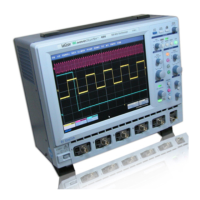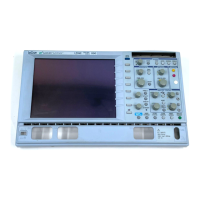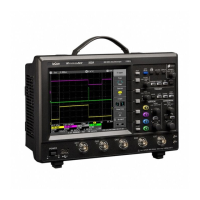Operator's Manual
112 WS-OM-E Rev B
Frequency Bins The FFT algorithm takes a discrete source waveform, defined over N points,
and computes N complex Fourier coefficients, which are interpreted as harmonic components of
the input signal.
For a real source waveform (imaginary part equals 0), there are only N/2 independent harmonic
components.
An FFT corresponds to analyzing the input signal with a bank of N/2 filters, all having the same
shape and width, and centered at N/2 discrete frequencies. Each filter collects the signal energy
that falls into the immediate neighborhood of its center frequency. Thus it can be said that there
are N/2 "frequency bins."
The distance in hertz between the center frequencies of two neighboring bins is always:
Delta f = 1/T
where T is the duration of the time-domain record in seconds.
The width of the main lobe of the filter centered at each bin depends on the window function
used. The rectangular window has a nominal width at 1.0 bin. Other windows have wider main
lobes (see table).
Frequency Range The range of frequencies computed and displayed is 0 Hz (displayed at the
left-hand edge of the screen) to the Nyquist frequency (at the rightmost edge of the trace).
Frequency Resolution In a simple sense, the frequency resolution is equal to the bin width
Delta f. That is, if the input signal changes its frequency by Delta f, the corresponding spectrum
peak will be displaced by Df. For smaller changes of frequency, only the shape of the peak will
change.
However, the effective frequency resolution (that is, the ability to resolve two signals whose
frequencies are almost the same) is further limited by the use of window functions. The ENBW
value of all windows other than the rectangular is greater than Delta f and the bin width. The table
of Window Frequency-Domain Parameters lists the ENBW values for the implemented windows.
Leakage In the power spectrum of a sine wave with an integral number of periods in the
(rectangular) time window (that is, the source frequency equals one of the bin frequencies), the
spectrum contains a sharp component whose value accurately reflects the source waveform's
amplitude. For intermediate input frequencies this spectral component has a lower and broader
peak.
The broadening of the base of the peak, stretching out into many neighboring bins, is termed
leakage. It is due to the relatively high side lobes of the filter associated with each frequency bin.
The filter side lobes and the resulting leakage are reduced when one of the available window
functions is applied. The best reduction is provided by the Blackman–Harris and Flattop windows.
However, this reduction is offset by a broadening of the main lobe of the filter.
